SNVS793D November 2011 – May 2015 LM3269
PRODUCTION DATA.
- 1 Features
- 2 Applications
- 3 Description
- 4 Revision History
- 5 Pin Configuration and Functions
- 6 Specifications
- 7 Detailed Description
- 8 Application and Implementation
- 9 Power Supply Recommendations
- 10Layout
- 11Device and Documentation Support
- 12Mechanical, Packaging, and Orderable Information
Package Options
Mechanical Data (Package|Pins)
- YZR|12
Thermal pad, mechanical data (Package|Pins)
Orderable Information
6 Specifications
6.1 Absolute Maximum Ratings
over operating free-air temperature range (unless otherwise noted)(1)(2)| MIN | MAX | UNIT | ||
|---|---|---|---|---|
| PVIN, VOUT to GND | −0.2 | 6 | V | |
| EN, VCON to SGND, PGND | −0.2 | PVIN + 0.2 V or 6 V(4) | V | |
| FB to PGND | −0.2 | VOUT + 0.2 V or 6 V(4) | V | |
| SW1, SW2 | −0.2 | PVIN + 0.2 V or 6 V(4) | V | |
| Continuous power dissipation(3) | Internally limited | |||
| Junction temperature, TJ-MAX | 150 | °C | ||
| Storage temperature, Tstg | −65 | 150 | °C | |
(1) Stresses beyond those listed under Absolute Maximum Ratings may cause permanent damage to the device. These are stress ratings only, which do not imply functional operation of the device at these or any other conditions beyond those indicated under Recommended Operating Conditions. Exposure to absolute-maximum-rated conditions for extended periods may affect device reliability.
(2) If Military/Aerospace specified devices are required, please contact the Texas Instruments Sales Office/Distributors for availability and specifications.
(3) Internal thermal circuitry protects the device from permanent damage. Thermal shutdown engages at TJ = 150°C (typical) and disengages at TJ = 125°C (typical).
(4) Whichever is smaller.
6.2 ESD Ratings
| VALUE | UNIT | |||
|---|---|---|---|---|
| V(ESD) | Electrostatic discharge | Human-body model (HBM), per ANSI/ESDA/JEDEC JS-001(1) | ±2000 | V |
(1) JEDEC document JEP155 states that 500-V HBM allows safe manufacturing with a standard ESD control process.
6.3 Recommended Operating Conditions
over operating free-air temperature range (unless otherwise noted)(1)(2)| MIN | NOM | MAX | UNIT | ||
|---|---|---|---|---|---|
| Input voltage | 2.7 | 5.5 | V | ||
| Output voltage | 0.6 | 4.2 | V | ||
| Recommended load current | 0 | 750 | mA | ||
| Junction temperature (TJ) | −30 | 125 | °C | ||
| Ambient temperature (TA)(3) | −30 | 85 | °C | ||
(1) Stresses beyond those listed under absolute maximum ratings may cause permanent damage to the device. These are stress ratings only, and functional operation of the device at these or any other conditions beyond those indicated under recommended operating conditions is not implied. Exposure to absolute-maximum-rated conditions for extended periods may affect device reliability.
(2) All voltages are with respect to the potential at the GND pins.
(3) In applications where high power dissipation and/or poor package thermal resistance is present, the maximum ambient temperature may have to be de-rated. Maximum ambient temperature (TA-MAX) is dependent on the maximum operating junction temperature (TJ-MAX-OP = 125°C), the maximum power dissipation of the device in the application (PD-MAX), and the junction-to ambient thermal resistance of the part/package in the application (RθJA), as given by the following equation: TA-MAX = TJ-MAX-OP – (RθJA × PD-MAX).
6.4 Thermal Information
| THERMAL METRIC(1) | LM3269 | UNIT | |
|---|---|---|---|
| YZR (DSBGA) | |||
| 12 PINS | |||
| RθJA | Junction-to-ambient thermal resistance(2) | 85 | °C/W |
(1) For more information about traditional and new thermal metrics, see the IC Package Thermal Metrics application report, SPRA953.
(2) Junction-to-ambient thermal resistance is highly application and board-layout dependent. In applications where high maximum power dissipation exists, special care must be paid to thermal dissipation issues in board design. Junction-to-ambient thermal resistance (RθJA) is taken from a thermal modeling result, performed under the conditions and guidelines set forth in the JEDEC standard JESD51-7.
6.5 Electrical Characteristics
Unless otherwise specified, typical (TYP) limits are for TA = TJ = 25°C, and minimum (MIN) and maximum (MAX) limits apply over the full operating ambient temperature range (−30°C ≤ TJ = TA ≤ +85°C). Unless otherwise noted, specifications apply to the Figure 16 with: PVIN = EN = 3.6V.(1)(2)| PARAMETER | TEST CONDITIONS | MIN | TYP | MAX | UNIT | |
|---|---|---|---|---|---|---|
| VFB, min | Min FB voltage | VCON = 0.2 V | 0.53 | 0.60 | 0.67 | V |
| VFB, max | Max FB voltage | VCON = 1.4 V | 4.13 | 4.2 | 4.27 | |
| IQ_PWM | Quiescent current | No switching(3) | 0.9 | 1.2 | mA | |
| ISHDN | Shutdown supply current | EN = 0 V, VCON = 0 V, SW1 = SW2 = VOUT = 0 V |
0.02 | 5 | µA | |
| ILIM_L | Input current limit (large) | Open loop(4)
VCON = 1.2 V |
1500 | 1700 | 1900 | mA |
| ILIM_S | Input current limit (small) | Open loop(4)
VCON = 0.2 V |
750 | 850 | ||
| Gain | Internal gain(5) | 0.2 V ≤ VCON ≤ 1.4 V | 3 | V/V | ||
| IEN | EN pin pulldown current | 5 | 10 | µA | ||
| IVCON | VCON pin leakage current | –1 | 1 | |||
| VIH | Logic high input threshold for EN | 1.2 | V | |||
| VIL | Logic low input threshold for EN | 0.6 | ||||
| IOUT_LEAKAGE | Leakage into VOUT pin of buck-boost | EN = 0 V, VOUT ≤ 4.2 V PVIN ≤ 5.5 V |
5 | µA | ||
(1) All voltages are with respect to the potential at the GND pins.
(2) Min and Max limits are specified by design, test, or statistical analysis. Typical numbers are not verified, but do represent the most likely norm.
(3) IQ specified here is when the part is not switching.
(4) The parameters in the electrical characteristics table are tested under open loop conditions at PVIN = 3.6 V.
(5) To calculate VOUT, use the following equation: VOUT = VCON × 3.
6.6 System Characteristics
The following spec table entries are specified by design and verification provided the component values in the typical application circuit are used (L = 2.2 µH, DCR = 110 mΩ, MIPSZ2520D2R2/FDK; CIN = 10 µF, 6.3 V, C1608X5R0J106K/TDK (0603); COUT = 4.7 µF, 6.3 V, C1608X5R0J475M/TDK (0603). These parameters are not verified by production testing. Typical (TYP) limits are for TA = TJ = 25°C; minimum (MIN) and maximum (MAX) limits apply over the full operating ambient temperature range (−30°C ≤ TJ = TA ≤ 85°C) and over the VBATT = PVIN = 2.7 V to 5.5 V, unless otherwise specified.| PARAMETER | TEST CONDITIONS | MIN | TYP | MAX | UNIT | |
|---|---|---|---|---|---|---|
| IOUT_MAX | Max output current | VBATT ≥ 3 V, VOUT = 3.8 V | 750 | mA | ||
| VCON_LIN | VCON linearity | 0.2 V ≤ VCON ≤ 1.4 V | –2.5% | 2.5% | ||
| VO_RIPPLE | Ripple voltage | VBATT ≥ 3.2 V, 0.6 V ≤ VOUT ≤ 4.2 V, 0 mA ≤ IOUT ≤ 430 mA, TA = 25°C |
15 | 50 | mV | |
| PFM ripple | VOUT = 0.6 V, IOUT = 5 mA | 45 | ||||
| Ripple voltage in mode transition | VBATT = 3 V to 5 V, TR = TF = 30 µs 3.3 V ≤ VOUT ≤ 4.2 V |
50 | ||||
| ΔVOUT | Line regulation | VBATT = 2.7 V to 4.7 V, VOUT = 3.8 V, IOUT = 500 mA |
10 | mV | ||
| Load regulation | IOUT = 0 mA to 500 mA, VBATT = 2.7 V to 4.7 V | 20 | ||||
| VOUT_TR | VOUT rise time | VBATT = 3.2 V to 4.7 V, VOUT = 1.4 V to 3 V, 0.1 µs < Tr_VCON < 1 µs RLOAD = 11.4 Ω |
10 | µs | ||
| η | Efficiency | VBATT = 3.7 V, VOUT = 0.6 V, IOUT = 10 mA −30°C ≤ TJ = TA ≤ 85°C |
61% | |||
| VBATT = 3.7 V, VOUT = 1 V IOUT = 20 mA −30°C ≤ TJ = TA ≤ 85°C |
78% | |||||
| VBATT = 3.7 V, VOUT = 1.4 V IOUT = 50 mA −30°C ≤ TJ = TA ≤ 85°C |
85% | |||||
| VBATT = 3.7 V, VOUT = 2.7 V IOUT = 200 mA −30°C ≤ TJ = TA ≤ 85°C |
95% | |||||
| VBATT = 3.7 V, VOUT = 3.3 V, IOUT = 480 mA −30°C ≤ TJ = TA ≤ 85°C |
94% | |||||
| VBATT = 3 V, VOUT = 3.6 V, IOUT = 200 mA −30°C ≤ TJ = TA ≤ 85°C |
95% | |||||
6.7 Switching Characteristics
over operating free-air temperature range (unless otherwise noted)| PARAMETER | TEST CONDITIONS | MIN | TYP | MAX | UNIT | |
|---|---|---|---|---|---|---|
| TON | Turnon time (time for output to reach 0V→90% × 3.5 V) | EN = L to H, VBATT = 3.7 V, VOUT = 3.5 V, IOUT = 0 mA −30°C ≤ TJ = TA ≤ 85°C |
35 | 50 | µs | |
| FOSC_PFM | PFM operating frequency | VBATT = 3.7 V, VOUT = 0.6 V, IOUT = 13 mA | 63 | kHz | ||
| FOSC_PWM | Internal oscillator frequency | PWM | 2.1 | 2.4 | 2.7 | MHz |
| DMAX | Maximum duty cycle | Boost | 50% | |||
| Buck | 100% | |||||
| VOUT_TR | VCON change to 90% | VBATT = 3.2 V to 4.7 V, VOUT = 1.4 V to 3 V, 0.1 µs < Tr_VCON < 1 µs RLOAD = 11.4 Ω |
10 | µs | ||
6.8 Typical Characteristics
(PVIN = EN = 3.6 V and TA = 25°C, unless otherwise noted)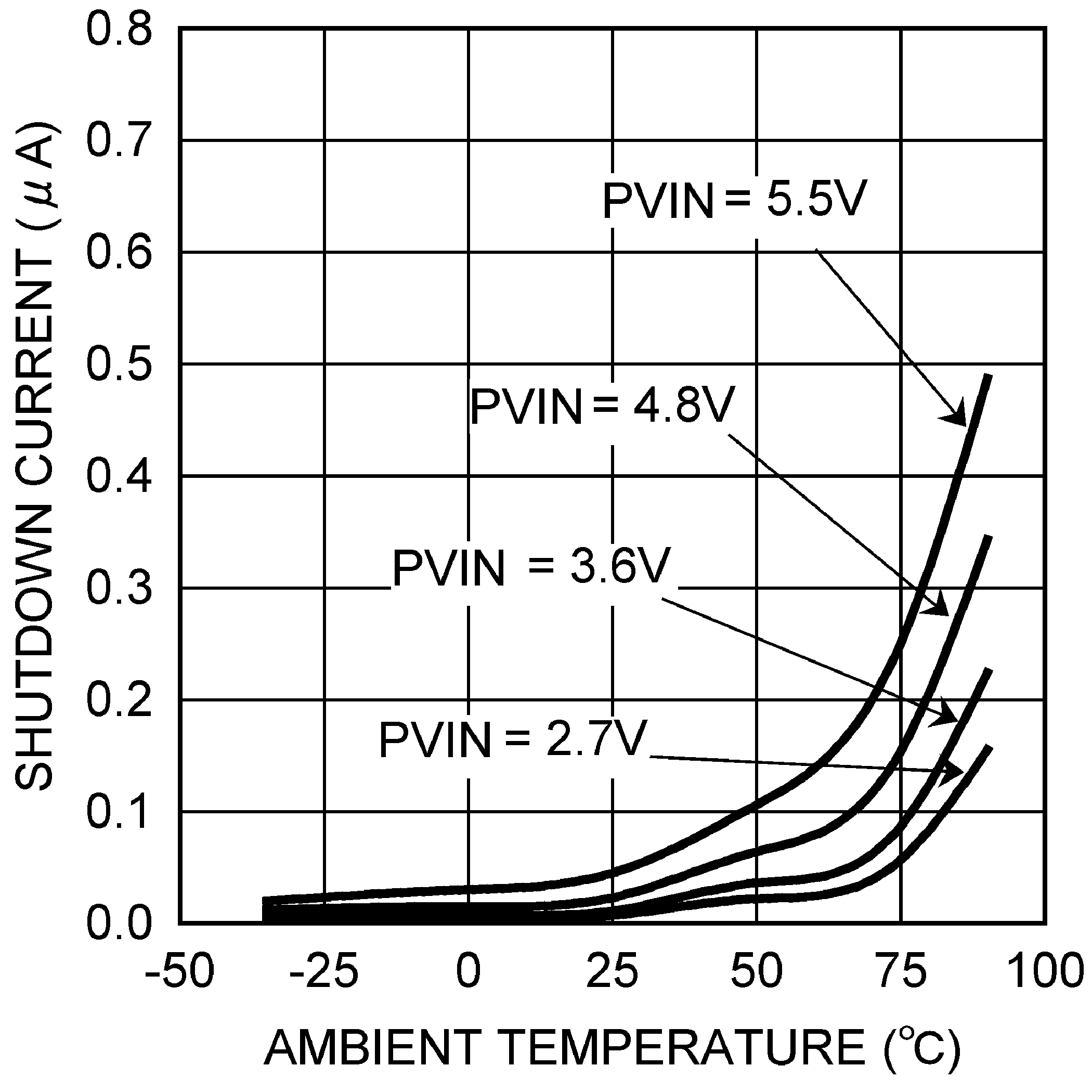
| VCON = VOUT = SW1 = SW2 = EN = 0 V |
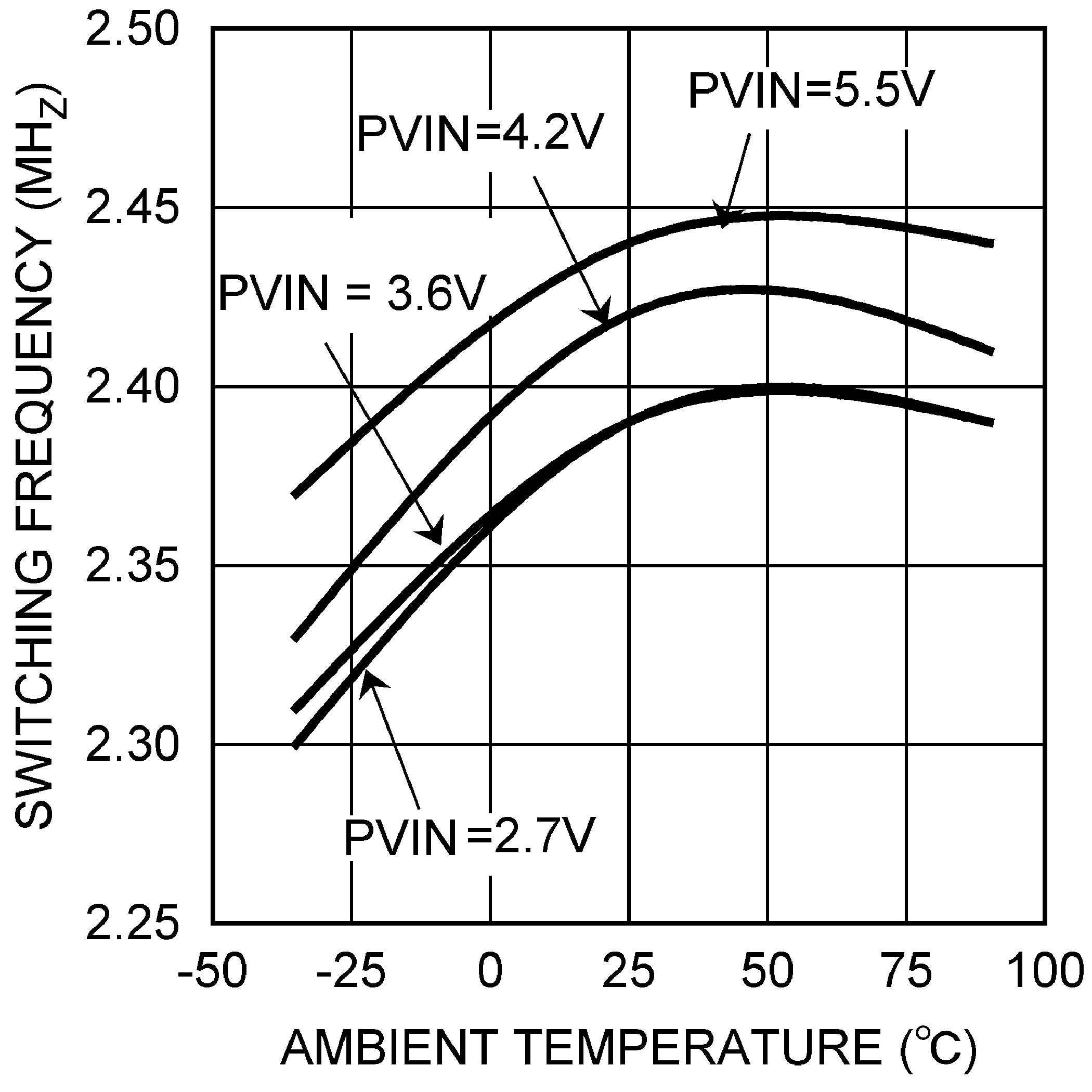
| VOUT = 3.5 V | IOUT = 300 mA |
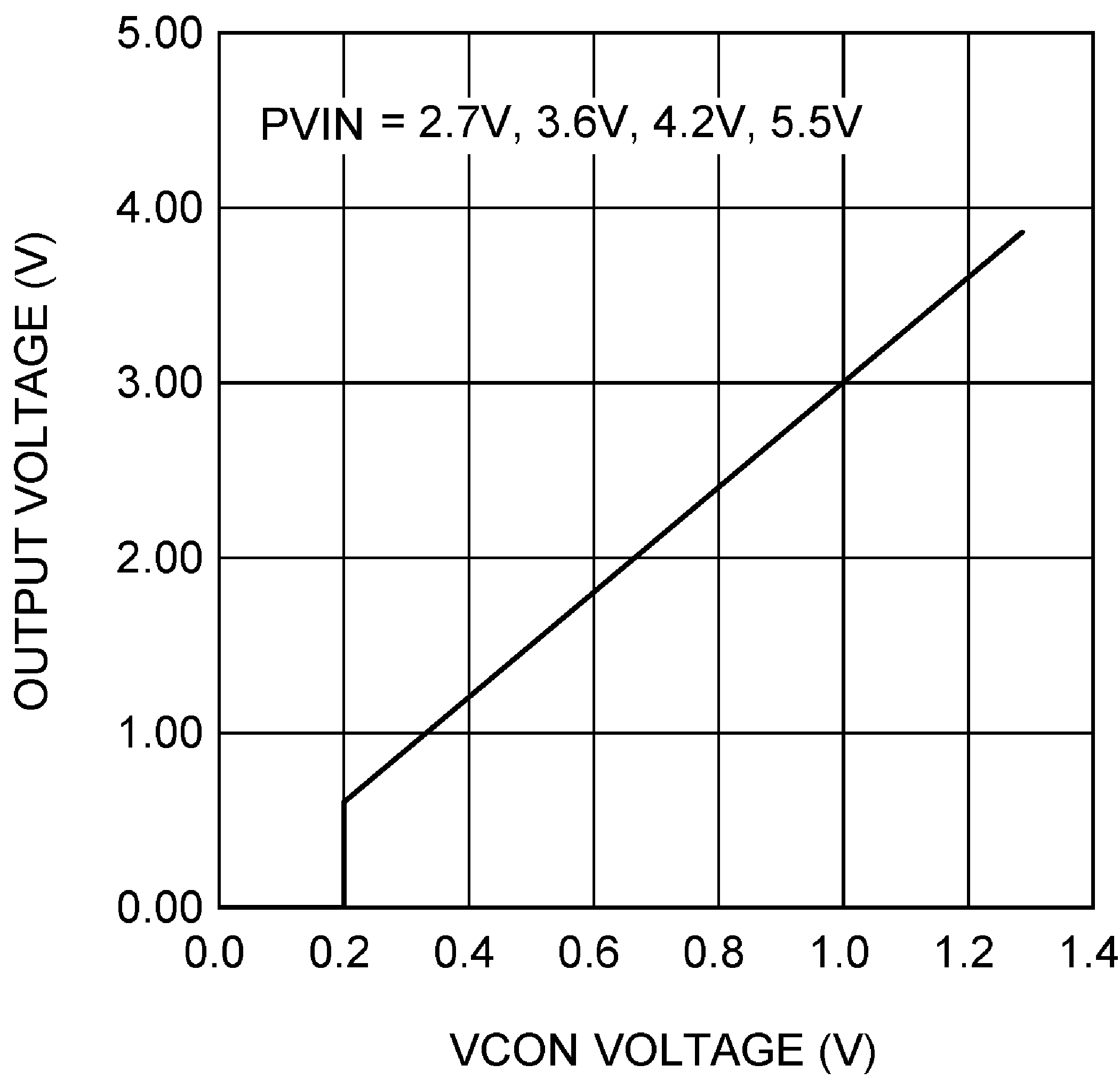
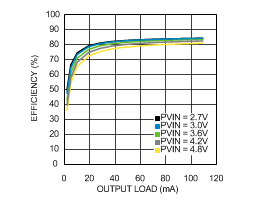
| VOUT = 1 V |
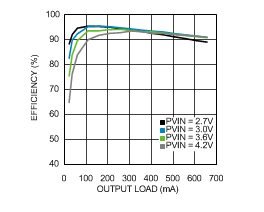
| VOUT = 2.4 V |
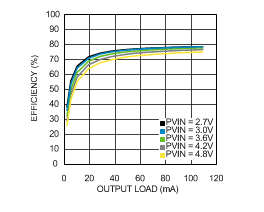
| VOUT = 0.6 V |
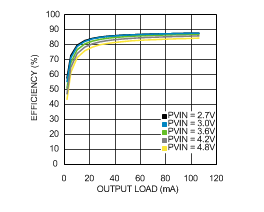
| VOUT = 1.4 V |
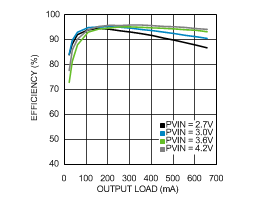
| VOUT = 3.6 V |